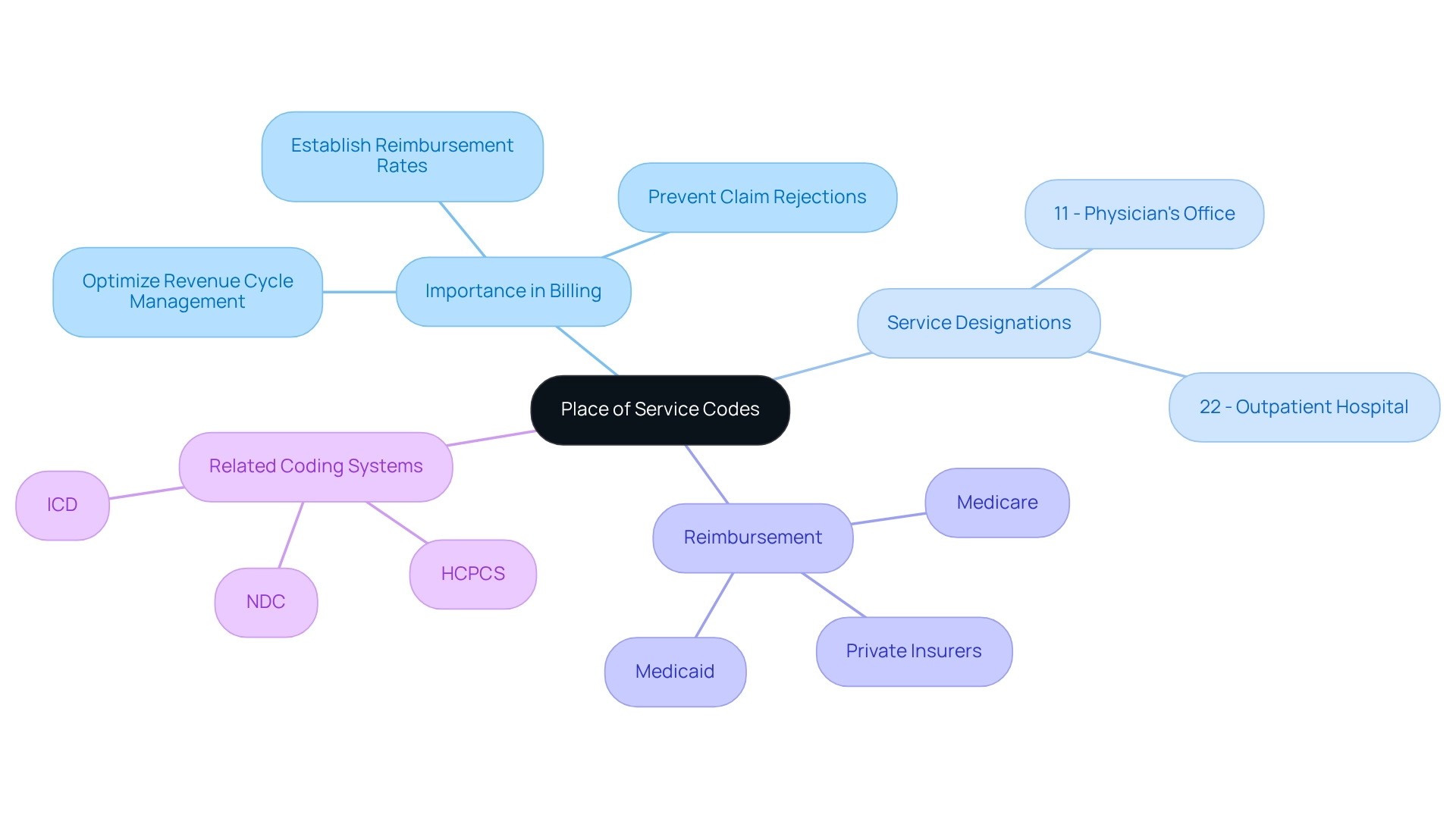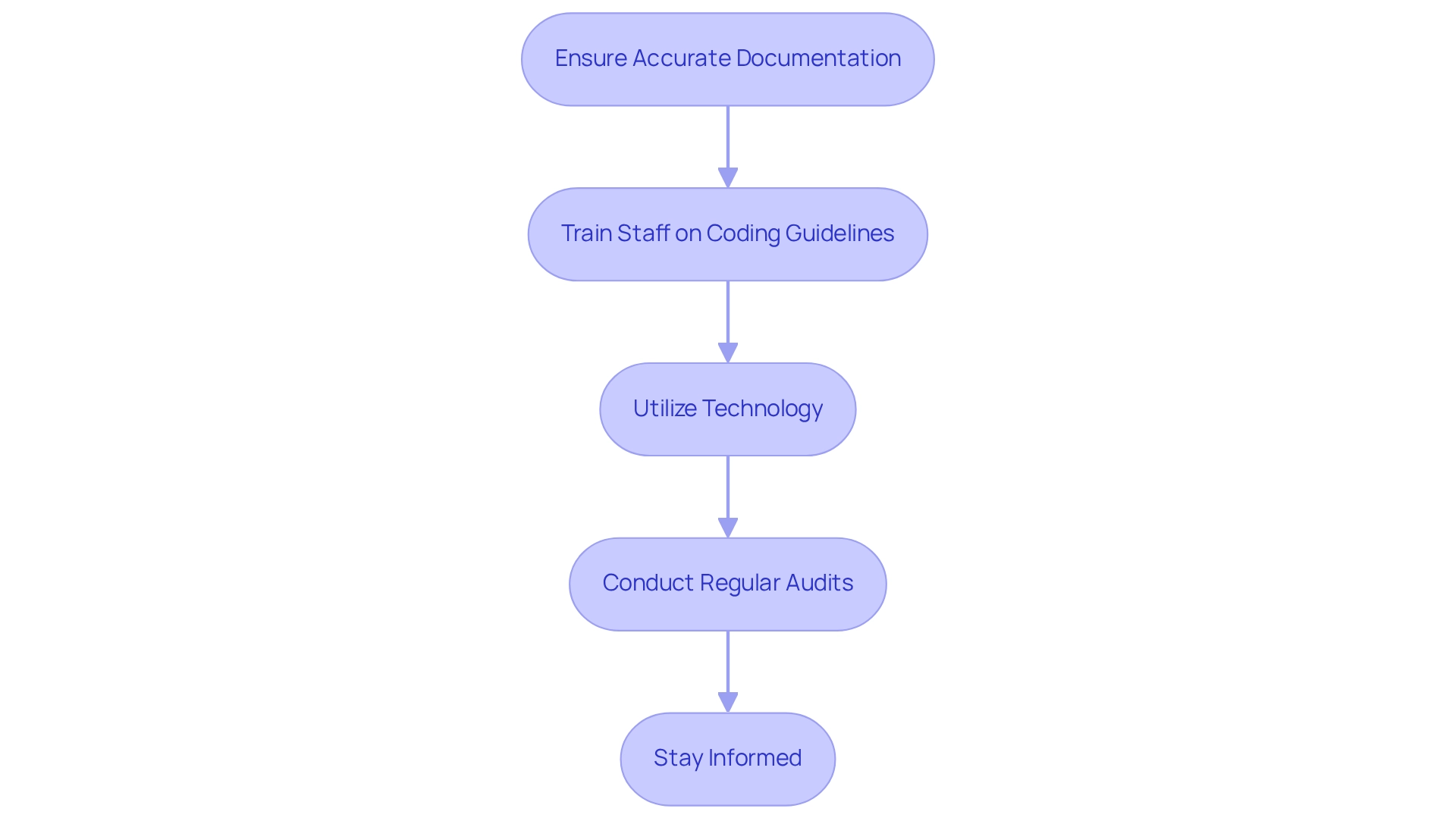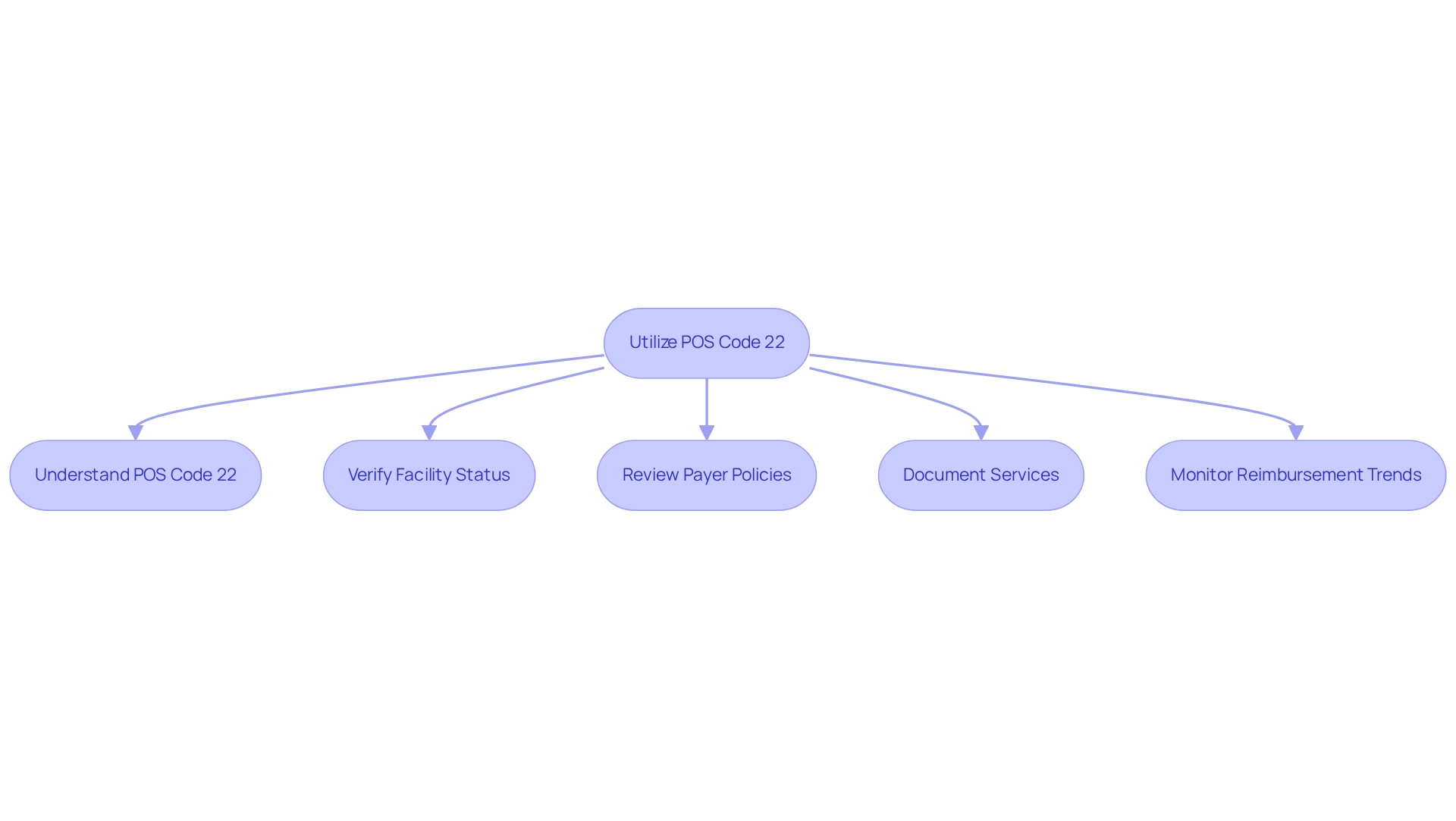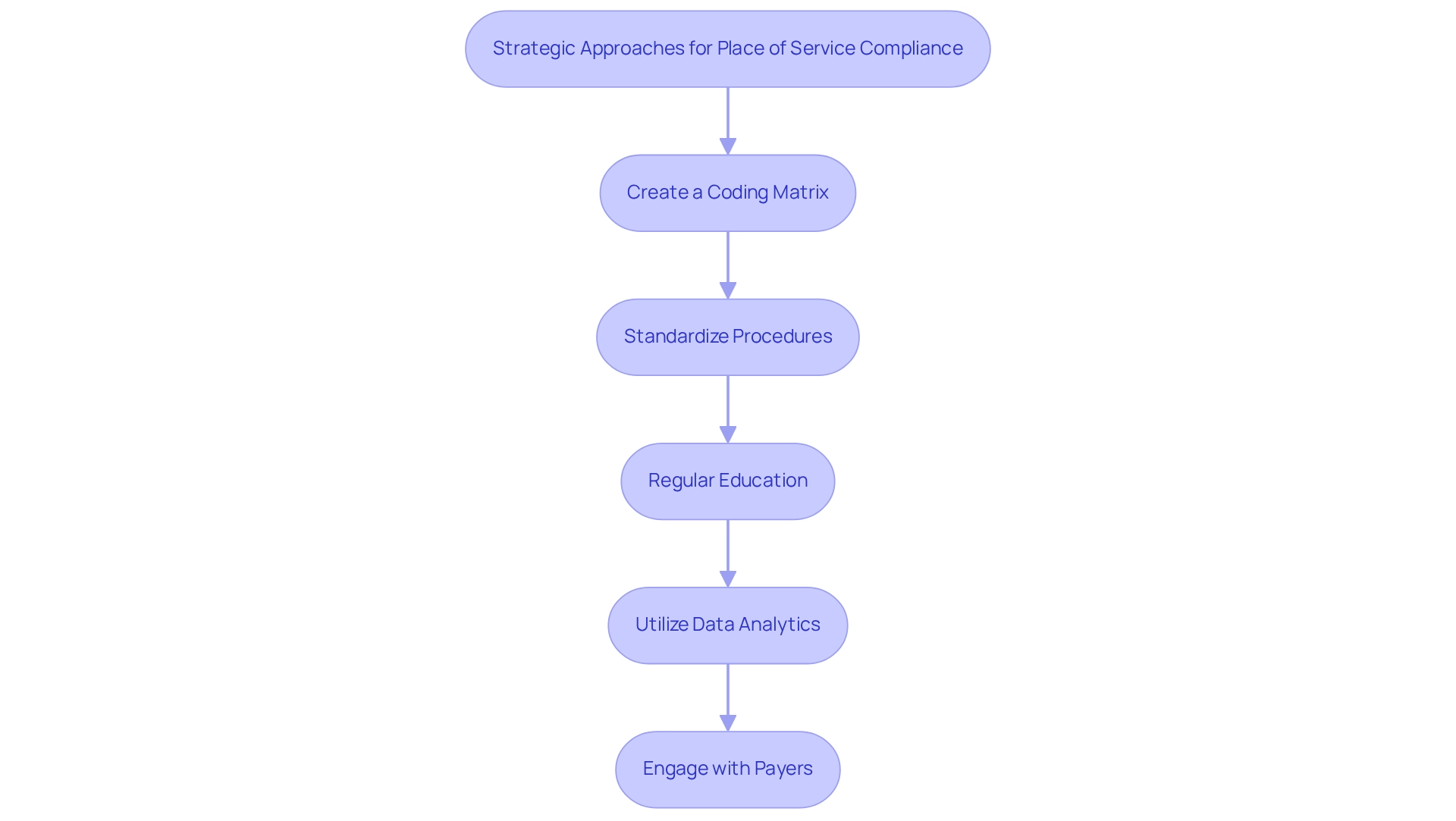Overview
The article presents effective strategies for utilizing Place of Service (POS) codes in medical billing, underscoring their critical importance in securing accurate reimbursement from insurers. It details best practices, including:
- The necessity of maintaining thorough documentation
- The importance of training staff on coding guidelines
- The advantages of leveraging technology to minimize errors
Collectively, these strategies empower healthcare providers to optimize their billing processes and ensure compliance with regulations. By implementing these approaches, organizations can enhance their operational efficiency and bolster their financial health.
Introduction
In the intricate world of medical billing, Place of Service (POS) codes play a pivotal role in ensuring accurate reimbursements for healthcare providers. These two-digit codes signify the location where care is delivered and significantly influence the financial dynamics between providers and insurers. The potential for claim denials and payment delays looms over incorrect coding, underscoring the critical need to master these codes.
As healthcare practices navigate the complexities of billing, understanding and implementing best practices for POS codes becomes essential for optimizing revenue and enhancing patient care. This article delves into the significance of POS codes, offering insights and strategies for effective implementation across various service settings.
Understand Place of Service Codes and Their Importance in Medical Billing
Place of Care (POS) identifiers are critical two-digit numbers utilized in medical billing to specify the location where healthcare activities are delivered. These identifiers play a vital role in establishing reimbursement rates from Medicare, Medicaid, and private insurers. For example, the 11 place of service designation signifies services rendered in a physician’s office, while designation 22 indicates outpatient hospital services.
The precise application of these identifiers is essential; erroneous entries can lead to claim rejections and delayed payments. Providers must remain informed about the latest coding guidelines from the Centers for Medicare & Medicaid Services (CMS) to ensure compliance and optimize revenue cycle management.
Furthermore, understanding how these systems interact with ICD, NDC, and HCPCS frameworks enables healthcare providers to navigate the complexities of billing and reimbursement more effectively. This ultimately enhances patient treatment pathways and ensures that interventions are appropriately documented and compensated.

Implement POS Code 11 for Office-Based Services: Best Practices
To effectively apply POS designation 11 for office-based support, providers should adhere to the following best practices:
-
Ensure accurate documentation: maintain thorough records of the services provided, including the date, time, and nature of each visit. This documentation not only supports the use of the 11 place of service identifier but is also essential for audits.
-
Train staff on coding guidelines: regularly instruct the team on the latest CMS guidelines concerning POS standards to prevent errors.
-
Utilize technology: leverage electronic health record (EHR) systems that integrate coding tools to simplify the invoicing process and reduce human error.
-
Conduct regular audits: implement periodic reviews of billing practices to identify and rectify any discrepancies in the use of POS classifications.
-
Stay informed: keep abreast of changes in coding regulations and payer policies to ensure compliance and optimize reimbursement rates.

Utilize POS Code 22 for Outpatient Hospital Services: Key Considerations
When utilizing POS identifier 22 for outpatient hospital support, providers must consider several critical factors. First, it is essential to comprehend the meaning of POS code 22, which is designated for services rendered in an outpatient hospital setting, including activities performed in hospital outpatient departments. Next, verifying the facility’s status is paramount; ensure that the facility is accurately classified as an outpatient hospital to avoid billing errors. Additionally, reviewing payer policies is crucial, as different payers may impose specific requirements for billing outpatient care. Therefore, examining these policies is vital for compliance, and thorough documentation of services is imperative, especially in relation to the 11 place of service requirements. It is important to include comprehensive details regarding the services provided, the location, and the personnel involved. Finally, monitoring reimbursement trends is necessary; analyzing reimbursement data can reveal patterns that allow for adjustments in billing practices, ultimately ensuring that the facility maximizes its revenue potential.

Adopt a Strategic Approach to Multiple Place of Service Codes for Compliance and Reimbursement
To effectively manage multiple 11 place of service identifiers, healthcare providers must implement strategic approaches that align with industry best practices.
- Create a Coding Matrix: A well-developed matrix detailing various POS identifiers relevant to different offerings and environments is a vital tool in identifying the 11 place of service. This resource empowers staff to swiftly identify the correct codes for usage.
- Standardize Procedures: Establishing standardized invoicing methods across the 11 place of service ensures consistency and accuracy in coding, which is essential for operational efficiency.
- Regular Education: Regular education on compliance requirements related to the 11 place of service coding minimizes errors and enhances staff understanding of the implications stemming from incorrect coding.
- Utilize Data Analytics: Leveraging data analytics is crucial for monitoring billing patterns and pinpointing areas for improvement in coding practices. This approach aids in recognizing trends that could lead to increased denials.
- Engage with Payers: Maintaining open lines of communication with payers clarifies ambiguities surrounding reimbursement policies and 11 place of service coding, ensuring alignment with payer expectations.

Conclusion
Navigating the complexities of medical billing necessitates a comprehensive understanding of Place of Service (POS) codes, which are essential for accurate reimbursement and effective revenue cycle management. By mastering these two-digit codes, healthcare providers can significantly reduce the risks associated with claim denials and payment delays, ultimately fostering improved patient care and financial stability.
Implementing best practices for specific codes, including POS code 11 for office-based services and POS code 22 for outpatient hospital services, is paramount. Accurate documentation, thorough staff training, and regular audits are vital components in ensuring compliance and optimizing billing processes. Furthermore, developing strategic approaches to manage multiple POS codes can enhance both accuracy and efficiency within healthcare practices.
In summary, the significance of POS codes in medical billing is profound. By prioritizing education, leveraging technology, and maintaining open communication with payers, healthcare providers can confidently navigate the intricate landscape of billing. Embracing these strategies not only safeguards against financial pitfalls but also ensures that patients receive the quality care they deserve.


